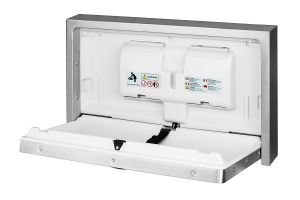Public baby changing facilities: Are yours good enough?
Public Baby Change Facilities: Is Your Business Doing Enough?
More than 700,000 children are born in the UK each year, yet while many public venues now provide baby changing units, the standard of these facilities can often be sub par. As a result, parents often find themselves changing their children in cramped and unsanitary conditions, or are forced to avoid certain venues, due to their lack of adequate facilities.
Naturally, no business wants to turn its customers away, so if it is viable for your establishment to provide baby-changing facilities, it is good practice to do so. Not only will this demonstrate your consideration for your customers, but it is also a socially responsible decision that protects children from the distress and discomfort of being changed in locations that are not fit for purpose.
![stainless steel recessed baby changing table]()
The Letter of the Baby Change Facilities Law
Unfortunately, there is no specific legal requirement for the provision of these amenities. However, the British Toilet Association advises that for every 10,000 people using an area, there should be at least one unisex baby-changing facility. Alternatively, changing units should be provided in both the male and female washrooms.
It is also important to keep in mind that nappies cannot be treated as general waste. Under the 1990 Environmental Protection Act sanitary waste must be disposed of via a licensed operator. You will also require clearly marked nappy disposal bin, and must keep all documentation of your sanitary waste disposal practices for a minimum of two years.
If parents of young children are regular visitors to your establishment, providing changing facilities is also a Health and Safety consideration. It is reasonable to assume that parents will at some point need to change their child, and if there is nowhere safe to do so, they might be forced to make use of whatever space is available.
If this then results in injury or illness, there is a chance your business could be found at fault. At the very least, it’s bad news for your reputation. In contrast, complying to washroom best practices will make your business a preferred stop.
On a similar note, installing unisex facilities is an important step in limiting gender discrimination. All too often, fathers are faced with the choice of avoiding going out alone with their child, or risking being unable to find anywhere to change them.
Accessible Facilities
It is worth remembering that changing units may not only be needed for babies, but also for children and adults with disabilities. Currently, there is an extreme lack of accessible changing facilities, meaning families of disabled children and adults are extremely limited in terms of the places they can comfortably visit.
The Changing Places campaign is a movement dedicated to the provision of fully accessible facilities. These differ from typical accessible toilets in that they contain a full-sized changing bench and hoist, a privacy screen, and enough space to accommodate an adult with two carers. Where possible, it is also recommended a shower be installed.
These facilities contribute to a drastically increased quality of life for disabled individuals, and it is the aim of the Changing Places movement to bring about a change in UK law to mandate the provision of such amenities in all public spaces.
Fit For Purpose
For many smaller businesses, one of the barriers to providing adequate facilities is space. A functional baby-changing unit needs to be situated in a clear area, so parents can move around the unit, and place items such as bags, buggies, and changing materials within reach.
Our vertical baby changing table and horizontal baby changing table save on space, ensuring the units can be easily folded away when not in use. Similarly, our wall mounted child seat will keep your toddler safe whilst changing your baby.
Many units come with built-in hooks, enabling parents to keep their belongings close to hand without cluttering the changing table.
-
Posted by Paul Thorn
23rd May 2019

 UK's Largest Stockholding
UK's Largest Stockholding Next Day Delivery Available
Next Day Delivery Available UK Mainland Delivery from £15
UK Mainland Delivery from £15 Minimum 1 Year Guarantee
Minimum 1 Year Guarantee